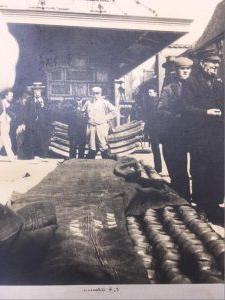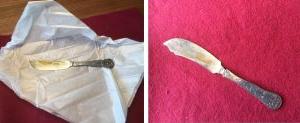By Viv Williams, Library Assistant and Processing Assistant
This past weekend saw the anniversary of the Mammoth Cheese, a 1235 lb. ball of cheese created by the farmers of Cheshire, Massachusetts as a gift to Thomas Jefferson! In an effort to pay fromage to such a lactiferous Massachusetts moment in history, I’ll be briefly highlighting some of the Society’s creamier collections.

The first and most relevant of these collections is a segment of the wooden screw that once belonged to the cider press used to create the legendary Mammoth Cheese. Our records indicate this screw segment was donated to the Society anonymously around 1960. Our repository also houses a copy of Lyman H. Butterfield’s paper, “Elder John Leland, Jeffersonian Itinerant.” This paper includes a detailed account of the reasoning and planning behind the cheesy gift to Jefferson. The account boasts of a vat, six feet in diameter and twenty-one inches thick, holding “fourteen hundred weight of curd.” According to the account, 900 cows were milked for the creation of the Mammoth Cheese. It’s safe to say the citizens of Cheshire were beside themselves with pride in regards to this whey/ty accomplishment. The publication also includes a cute little ditty titled, “Ode to the Mammoth Cheese.” The opening lines read, “Most Excellent– far fam’d and far fetch’d Cheese! / Superior far in smell, taste, weight and size, /To any ever form’d neath foreign skies…” As extravagant as these initial assertions are, I found myself most tickled by the closing lines. “All that we want or wish for in life’s hour, / Heaven still will grant us– they are only these, / Poetry–Health–Peace–Virtue–Bread and Cheese.” Forget life, liberty, and the pursuit of happiness! Let them eat cheese!

But my cheese puns don’t stop there, and neither do the collections. I couldn’t possibly highlight MHS collections without mentioning the Adams family. Turns out Charles F. Adams II had an eye for gouda cheese. The photograph below was taken in Allemaar, Holland in 1898. It features a sharper than cheddar Charles observing the operations of a cheese market weighing house.

The next item on the list may find particular interest with any silversmithing enthusiasts. It is a mysteriously unidentified cheese knife. It was found in a safe along with several other pieces of mystery silverware back in 1974. You’ll notice from the photos that there are traces of gilt on both the blade and handle.

Cheese Knife
The final two collections I have to discuss are intriguing because they are cheese related in name alone, the first being the records of the Belmont, Massachusetts Cheese Club. The Cheese Club is a men’s intellectual and social club revolving around the presentation of scholarly papers. The records include meeting minutes, correspondence, member lists, papers read at club meetings, and financial material. I searched through the club’s documented history hoping to locate some witty and humorous explanation as to why this group would name themselves the “Cheese Club” but could only come up with a few lines that indicated large amounts of cheese and ginger ale being consumed for refreshment at earlier meetings. In fact, the group that began meeting in 1895 did not begin referring to themselves as the “Cheese Club” until 1940.

The final item in our cheese round lends a shout out to environmental conservationists. It’s a printed broadside of a poem called “The Legend of ‘Cheese Rock’” written by Elizur Wright. Elizur is often recognized as the “father of life insurance,” but he had several reform interests throughout his life such as abolitionism and conservation. In the midst of bustling New England urban development in the mid-19th century, Wright pushed for the preservation of forests and parks, particularly in places like Blue Hills and Middlesex Fells. He helped organize the Middlesex Fells Association which pushed for legislation to the preserve forests in the area. In order to gain support, the group hosted “Forest Festivals” throughout the area, and the aforementioned poem was written for one such occasion. The poem alludes that the hill now referred to as Winthrop Hill or “Mount Winthrop” was previously christened “Cheese Rock” after the trio, “Winthrop, Nowell, [and] Eliot” shared a meal of “simple cheese” there.
I hope I’m not provolone in being fascinated by these cheese related objects. In queso you are interested in viewing any of these items in person in our library or have other questions about the collection, please visit the library or contact a member of the library staff for further assistance. You won’t raclette it!

